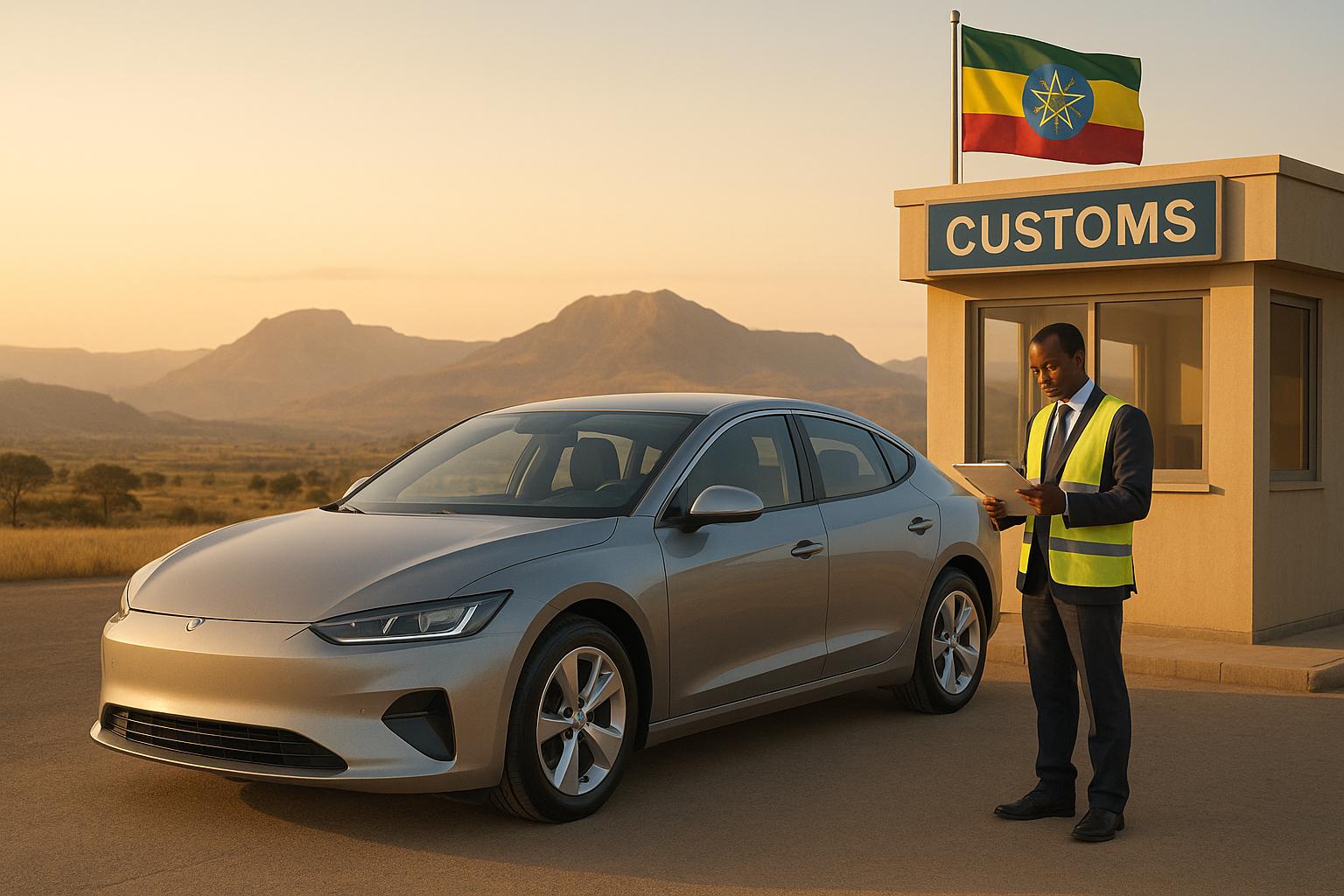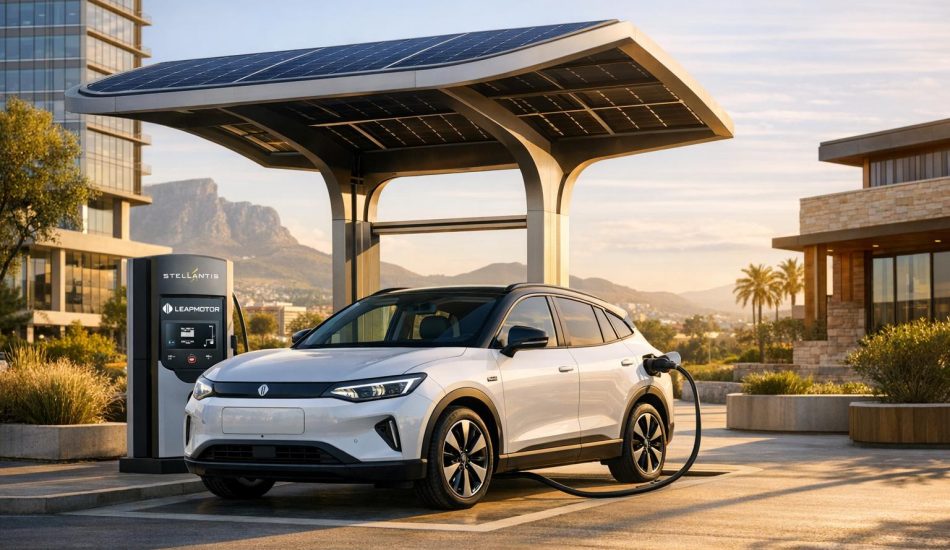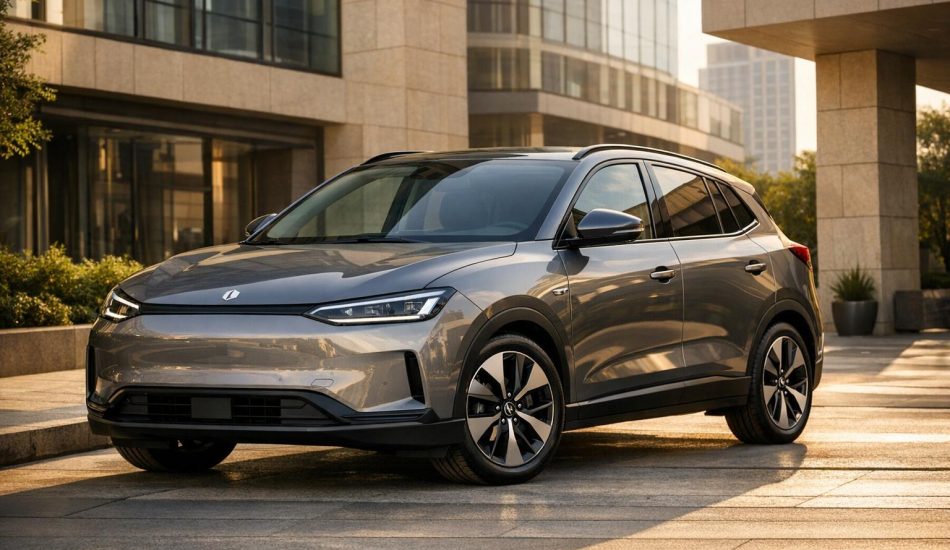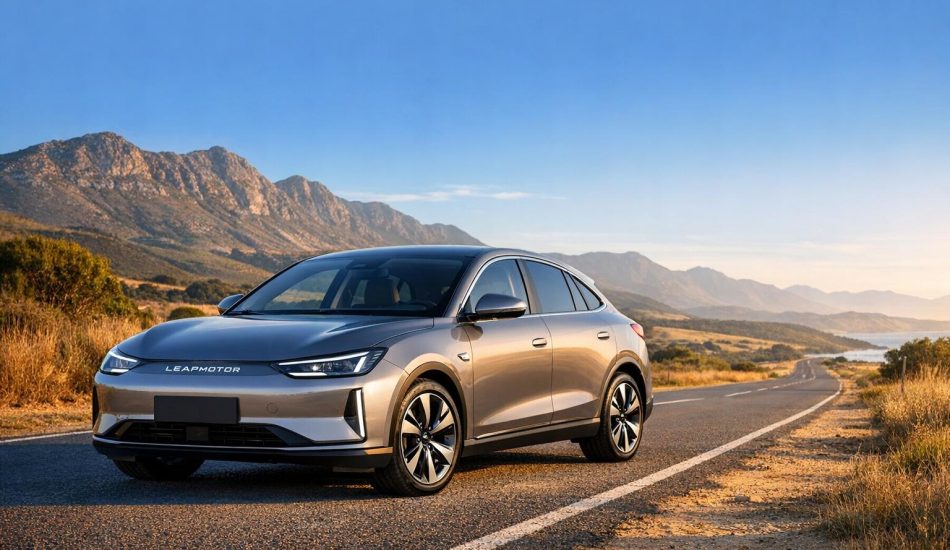
- Ban on Gasoline and Diesel Vehicles: Importing internal combustion engine (ICE) vehicles, including kits, is prohibited. EVs are the only option.
- Lower Taxes for EVs: Fully assembled EVs face a 15% import tax, while semi-assembled kits are taxed at 5%. CKD kits for local assembly are tax-free.
- Growing EV Adoption: Over 100,000 EVs are already on the road, with a target of 500,000 by 2030.
- Affordable Electricity: At $0.03 per kWh, operating EVs is cost-effective compared to rising fuel prices.
- Infrastructure Expansion: Charging stations are planned every 31–75 miles, supporting long-distance travel.
- Compliance Rules: EVs must meet safety, battery, and performance standards, including a minimum range of 186 miles for cars and a 7-year battery lifespan.
- Incentives for Local Assembly: Companies assembling EVs locally benefit from reduced costs and tax waivers on parts.
Ethiopia’s focus on EVs is reshaping its automotive landscape. Importers and manufacturers who understand these regulations and opportunities can thrive in this evolving market.
electric car in ethiopia tax free| how car tax is calculated in Ethiopia | car import in ethiopia|#3
Customs Procedures and Required Documents
Bringing an EV into Ethiopia involves thorough documentation and strict adherence to customs protocols. While the process for electric vehicles is more straightforward than for traditional internal combustion engine (ICE) vehicles, paying close attention to the details is critical. Below, we’ll break down the necessary documents, customs clearance steps, and recent policy updates to help you navigate the process with ease.
Documents Needed for EV Imports
To successfully import an EV, you’ll need a full set of documents. Start with a commercial invoice that provides detailed information about the vehicle, including its description, price, and the details of both the buyer and seller. A packing list is also essential, offering specifics about the goods and their packaging, which helps customs verify the shipment.
The required transportation document will depend on how the vehicle is shipped. For sea freight, a Bill of Lading is necessary, listing details like the chassis number, engine number, cubic capacity, year of manufacture, brand, make, and model. For air freight, you’ll need an Air Waybill with similar information.
An Import Permit from Ethiopia’s Ministry of Trade is mandatory for all vehicle imports. For new or nearly new EVs, a Certificate of Conformity (COC) is required to prove the vehicle meets Ethiopian standards. This certificate typically includes a Vehicle Inspection Report, an Environmental Compliance Sheet, and a Vehicle Type Approval Certificate.
Additional documents include a Certificate of Origin, which can help secure trade agreement benefits, and the Vehicle Purchase Invoice as proof of purchase. You’ll also need the Original Registration Documents to verify the vehicle’s history and ownership. For non-exempt imports, evidence of VAT payment is necessary, along with a valid driver’s license and international insurance. Remember, all documents must be submitted in their original form with certified Amharic translations, as per Ethiopian regulations.
Customs Clearance Steps
The customs process begins with submitting a customs declaration along with all required documents to Ethiopian customs. Import tax rates are 15% for completely built EVs (CBU) and 5% for semi-knocked down (SKD) kits. Additionally, a 15% VAT applies across the board. After taxes are paid, customs officials carry out a physical inspection to ensure the vehicle matches the documentation and complies with Ethiopian standards.
Once the inspection is complete, you’ll receive a release notice, allowing you to collect your vehicle. Since Ethiopia is landlocked, most vehicles are shipped to Djibouti Port and then transported overland to Ethiopian cities. Transport costs typically range from $500 to $1,000 per vehicle.
To simplify the process and avoid delays, consider hiring a licensed customs broker. They can handle document submissions and assist with any potential issues, helping you save time and avoid financial penalties.
2025 Updates to Customs Rules
Ethiopia’s customs policies have seen significant updates aimed at promoting EV imports. As of May 2025, the government expanded its ban on ICE vehicles to include semi-knocked down (SKD) and completely knocked down (CKD) kits, while continuing to exempt electric and hybrid vehicles. This builds on the January 2024 ban, which initially applied only to fully built fuel-powered vehicles. Now, all internal combustion engine vehicles are prohibited.
Another major update involves tax incentives for EV imports. The government has removed all taxes on spare parts for companies and standardized duties – 15% for fully assembled EVs and 5% for SKD kits. Locally assembled EV parts now benefit from "almost zero percent" import tariffs.
These changes align with Ethiopia’s ambitious goal of having 500,000 EVs on the road by 2030. Rising fuel prices – jumping from $0.4 per liter in January 2023 to $0.8 per liter by January 2025 – further strengthen the case for EV adoption, making them a more economical choice for consumers.
Commissioner Debele highlighted the government’s dedication to supporting importers, stating:
"This adjustment is crucial for speeding up the importation of commodities necessary for our manufacturing industries. We are committed to ensuring that our policies align with the needs of our industrialists and contribute positively to Ethiopia’s economic growth."
Next, we’ll explore compliance rules and local assembly standards that work in tandem with these customs procedures.
Compliance Rules for EV Imports and Local Assembly
Once electric vehicles (EVs) clear customs, importers must navigate a detailed set of compliance and assembly standards to fully access Ethiopia’s market advantages. These regulations go far beyond basic customs procedures. The Department of Transport Management (DoTM) is currently developing the Vehicle Import, Production and Assembly Directive, 2025, which will outline technical and safety standards for EV imports. This directive ensures that only vehicles meeting specific criteria can enter Ethiopia, building on the earlier customs requirements.
Technical and Safety Requirements
The upcoming directive establishes clear performance benchmarks for imported EVs. For example:
- Electric bikes and three-wheelers must have a minimum range of 62 miles (100 km) per charge.
- Four-wheeled EVs need to achieve at least 186 miles (300 km) per full charge.
These standards are tailored to Ethiopia’s varied terrain and long-distance travel needs.
Battery requirements are equally rigorous. EV batteries must last at least 7 years or 3,000 charge cycles, whichever comes first. Additionally, they must adhere to international standards like UL 2580, IEC 62133, AIS 049, or IS 17017 and include thermal management systems to handle Ethiopia’s climate.
To address road conditions, the directive specifies ground clearance levels. Standard cars must have at least 7.1 inches (180 mm) of clearance, while buses and SUVs require between 9.8 to 11.8 inches (250–300 mm). All vehicles must also meet ISO 8608 road surface standards to ensure durability on Ethiopia’s roads.
Safety features are mandatory. Every EV must come equipped with Electronic Brake Distribution (EBD) and Anti-lock Braking System (ABS) as standard. The DoTM reserves the right to inspect vehicles before registration to confirm they meet these roadworthiness standards.
Charging Infrastructure Licensing Rules
The Ethiopian Petroleum and Energy Authority regulates EV charging stations. A directive covering licensing, tariffs, power supply standards, and security measures is already in effect.
All EV charging providers must secure proper licensing, with companies operating before the directive’s enforcement given a six-month grace period to comply. Licenses are valid for two years and must be renewed three months before expiration.
Ethiopia’s infrastructure plan aims to establish charging stations every 31 to 75 miles (50 to 120 km) nationwide. Fast charging stations for long-range and heavy-duty EVs must include at least two chargers with a capacity of 100 kW each, supporting both CCS and CHAdeMO connectors.
For now, public EV charging stations follow the general electricity tariff. However, the authority may introduce new tariff categories as the market evolves. These measures align with Ethiopia’s target of replacing 30% of internal combustion engine vehicles with EVs within the next decade.
Local Assembly and Retrofitting Standards
Ethiopia promotes local EV assembly through tax breaks and reduced import duties on semi-assembled vehicles. These incentives also support the government’s program to retrofit traditional fuel-powered cars into EVs.
Several companies are already advancing local assembly efforts. For instance, Huajian Group is importing GAC-brand EVs with plans to transition to local assembly and manufacturing. Similarly, Tamrin Motors has partnered with JAC Motors to start assembly operations. In April 2025, Belayneh Kindie Group launched East Africa’s largest electric bus operation, receiving 100 electric buses from China’s Xiamen Golden Dragon Bus Co Ltd.
Local assemblers must meet the same technical standards as importers. They must establish service centers, train technical staff, and maintain adequate spare parts inventories before launching operations. Additionally, companies are required to offer six-month warranties, covering repairs or replacements for manufacturing defects (excluding user negligence).
The Ministry of Industry is working to expand local manufacturing capacity and improve EV charging infrastructure to support this transition. However, limited access to foreign currency for importing components from China remains a significant challenge for local assembly.
Both importers and local assemblers must obtain prior approval from the DoTM. This ensures that all parties understand their compliance obligations and have the necessary infrastructure to operate effectively in Ethiopia.
Government Incentives and Financial Benefits
Ethiopia is taking bold steps to make electric vehicles (EVs) more accessible by offering financial incentives that reduce import costs. These measures aim to cut down on fuel imports and capitalize on the country’s 90% reliance on hydropower for electricity generation.
Tax Cuts and Import Duty Waivers
The tax system for EVs in Ethiopia is far more lenient compared to that for traditional internal combustion engine (ICE) vehicles. EVs are exempt from VAT, excise tax, and surtaxes. On the other hand, ICE vehicles are subject to a 15% VAT, up to 100% excise tax, a 10% surtax, and a 3% withholding tax.
For customs duties, fully assembled EVs are taxed at 15%, semi-assembled EVs at just 5%, and completely knocked-down (CKD) kits for local assembly are entirely tax-free. These policies have had an immediate impact, with the price of electric cars reportedly dropping by 40–50% under the new tax regulations. For businesses, assembling EVs locally using CKD kits offers the most cost-effective option, thanks to the zero tax burden.
The government has set ambitious goals for EV adoption, forecasting 148,000 passenger EVs and 4,855 commercial EVs on the road by 2032. This is a significant leap for a country where vehicle ownership is among the lowest globally, with only about one vehicle per 100 people.
These tax incentives are part of a broader strategy, which also includes initiatives to develop charging infrastructure.
Incentive Benefits Comparison
Ethiopia’s simplified tax structure for EVs significantly reduces costs for both importers and end-users, encouraging rapid market expansion.
| Vehicle Type | Import Duty | VAT | Excise Tax | Surtax | Overall Tax |
|---|---|---|---|---|---|
| ICE Vehicles | Standard rates | 15% | Up to 100% | 10% | High (multiple taxes) |
| Fully Assembled EVs | 15% | Exempt | Exempt | Exempt | Low (customs only) |
| Semi-Assembled EVs | 5% | Exempt | Exempt | Exempt | Very Low |
| CKD EVs (Local Assembly) | 0% | Exempt | Exempt | Exempt | None |
EV owners benefit from more than just lower taxes. They also gain access to public charging stations and special license plates, further incentivizing adoption.
Charging Infrastructure Support Programs
To complement the tax incentives, the Ethiopian government is focusing on building a robust charging infrastructure. Plans include installing charging stations every 31 to 75 miles. This network is designed to support the country’s goal of having 500,000 EVs on the road within the next decade, replacing 95% of fuel-powered vehicles.
Ethio Telecom has taken a leading role in this effort. In April 2025, the company launched its second ultra-fast EV charging station in Addis Ababa. Equipped with 16 high-capacity chargers, the station can serve up to 32 vehicles at once.
"This initiative aligns with Ethio Telecom’s vision as a leading digital solutions provider and is part of our Digital Ethiopia journey."
– CEO Frehiwot Tamiru
The government has also established a regulatory framework to support this expansion, covering key aspects such as licensing, service tariffs, power supply standards, and security measures.
Ethiopian Minister of Transport and Logistics Alemu Sime emphasized the environmental and practical benefits of EVs, stating:
"These electric buses are environmentally friendly with zero emissions and offer a comfortable ride offering high passenger capacity"
Beyond installing charging stations, the government is actively facilitating EV imports and ensuring that the charging infrastructure can meet the growing demand. With the national car fleet expected to grow from 320,000 in 2024 to 415,000 by 2030 – and EVs projected to make up 113,000 of those vehicles – developing a strong charging network is essential for sustaining this momentum.
sbb-itb-99e19e3
Common EV Import Challenges and Solutions
Even with Ethiopia’s supportive policies, importing electric vehicles (EVs) comes with its fair share of challenges that require thoughtful planning and strategic solutions.
Managing High Upfront Costs and Financing
One of the biggest barriers to EV adoption in Ethiopia is the high upfront cost. Electric two-wheelers range between 150,000–200,000 birr ($1,100–$1,500), while passenger EVs can cost around $20,000. For many, these prices are simply out of reach.
"Higher purchase costs and lack of access to financing are also bigger obstacles to EV adoption in the countryside, where there are fewer banks and wages tend to be lower."
Take Dubancho village, for example. A taxi rider here earns roughly 900 birr ($6.90) daily after fuel subsidies were removed. At this rate, even the cheapest electric two-wheeler would require over five months of earnings, assuming no other expenses.
To ease this burden, local credit companies are stepping in. Mobilit-E, for instance, offers financing plans like a 20% down payment for BYD vehicles. Rising fuel costs are also making EVs a more attractive option. Gasoline prices have doubled from $0.40 per liter in January 2023 to $0.80 per liter by January 2025, and with plans to add a 15% VAT and 15% excise tax on fuel, the economic case for EVs is becoming more compelling. Local assembly using duty-free CKD kits further reduces costs.
However, financing isn’t the only hurdle. Reliable after-sales support is equally important to ensure long-term adoption.
Finding Spare Parts and Maintenance Services
A lack of spare parts and trained mechanics is another significant issue. Many EV owners face long delays when trying to repair their vehicles, with some cars sitting idle for weeks or months.
"If anything goes wrong with the car, like if there’s no official showroom for that certain car here, you’re going to have to order the spare part, and then that would take like weeks to months. So basically the car just sits at home if it was like a very important spare part."
To address this, forming partnerships with manufacturers is key. For example, Moenco’s collaboration with BYD includes efforts to provide better service. Training programs for local technicians, supported by colleges and manufacturers, can also help close the skills gap. Establishing local warehouses for spare parts would further reduce repair delays and costs.
Solving these maintenance challenges is just as critical as tackling the logistical and regulatory aspects of importing EVs.
Handling Regulatory and Shipping Issues
In February 2024, Ethiopia banned gasoline and diesel vehicle imports, a move announced by Transport and Logistics Minister Alemu Sime to encourage EV adoption. While this simplifies regulations for EVs, shipping and customs processes remain complex.
As a landlocked nation, Ethiopia relies on neighboring ports like Djibouti, Mombasa (Kenya), and Dar es Salaam (Tanzania) for vehicle imports. Shipping costs are steep – Roll-on/Roll-off shipments run $3,600–$5,000 per vehicle, container shipping costs $5,000–$7,200, and overland transport adds another $500–$1,000.
To navigate these challenges, working with experienced logistics providers, such as All TransportDepot Inc., can streamline the process. Proper documentation is essential to avoid customs delays, and licensed customs brokers can help ensure smooth operations. Ethiopia’s tax incentives, including a 15% VAT exemption and relief from consumption tax and surtax, further enhance the appeal of EV imports. Staying updated on regional shipping laws and maintaining strong relationships with logistics experts are vital for minimizing delays and costs.
Key Points for Ethiopia’s EV Imports in 2025
Ethiopia’s shift toward electric vehicles (EVs) in 2025 presents promising opportunities for businesses and individuals who can navigate the import process effectively. With the country enforcing a complete ban on gasoline and diesel vehicle imports starting February 2024, the transition to EVs is well underway. Over 100,000 electric vehicles have already been imported since the ban came into effect.
The customs process for EV imports is relatively straightforward but demands attention to detail. As a landlocked country, Ethiopia depends on ports in neighboring nations like Djibouti for vehicle entry. Importers must ensure all required documentation is in order, including commercial invoices, certificates of origin, and import permits. Additionally, lithium battery shipments must be transported using UN Class 9–certified carriers with "All-Risks" insurance coverage.
Ethiopia has also introduced fiscal policies that encourage EV imports. Customs duties for EVs are relatively low – 15% for fully assembled units and 5% for semi-knocked-down (SKD) kits. However, a 15% VAT was reinstated in August 2024, which slightly offsets these reduced duties. On the infrastructure front, the government is focused on expanding charging stations, as highlighted by transport ministry expert Yizengaw Yitayih:
"If we get international loans or grants, we can expand charging stations to rural communities, thereby advancing the adoption of electric vehicles throughout the country."
Mandatory safety and environmental certifications have also supported the deployment of over 2,200 charging stations. Ethiopia’s reliance on hydroelectric power, which provides electricity at extremely low rates (around $0.01 per kWh), makes EVs an economical choice for consumers. With projections estimating the national car fleet to reach 415,000 vehicles by 2030 – 113,000 of which are expected to be EVs – early adopters have a chance to secure a strong foothold in this growing market.
To simplify the import process, platforms like EV24.africa offer a reliable solution by connecting buyers with verified vehicles from leading brands such as Tesla, BYD, and Hyundai. With transparent pricing and delivery services to 54 African countries, the platform ensures compliance with Ethiopia’s evolving regulations, making it easier for importers to adapt to changing policies.
Success in Ethiopia’s EV market hinges on staying informed about regulatory updates, partnering with experienced logistics providers, and taking advantage of government incentives. As Bareo Hassen, state minister of transport and logistics, stated, "the expansion of EVs and infrastructure is one of the primary initiatives to establish a sustainable and environmentally friendly transportation system". This transition marks a pivotal moment for Ethiopia, offering a unique opportunity for those ready to embrace the electric vehicle revolution.
FAQs
What are the technical and safety standards for importing electric vehicles into Ethiopia in 2025?
To bring electric vehicles into Ethiopia in 2025, you’ll need to ensure they comply with specific technical and safety standards. These cover key areas like electrical safety, protection against electric shocks, and adherence to energy efficiency rules. The goal is to guarantee that the vehicles are safe, environmentally conscious, and align with Ethiopia’s efforts to promote electric mobility.
In addition, imported EVs must meet standards for battery safety, proper insulation, and overall system durability. It’s crucial to check Ethiopia’s most up-to-date import regulations to make sure your vehicle meets all the required criteria before proceeding with shipping.
What tax incentives does Ethiopia offer for electric vehicles compared to traditional gas-powered cars?
Ethiopia’s Tax Benefits for Electric Vehicles
Ethiopia offers generous tax breaks to promote the use of electric vehicles (EVs). When it comes to importing EVs, buyers enjoy full exemptions from VAT, excise tax, and surtax. On top of that, customs duties are slashed to just 15% for fully assembled EVs and an even lower 5% for semi-knocked-down units.
On the flip side, gas-powered vehicles face much steeper taxes. These include an excise tax of up to 100%, 15% VAT, and additional surtaxes. This stark contrast in taxation makes EVs a far more affordable and appealing choice for individuals and businesses aiming to embrace cleaner, more sustainable transportation options.
What are the main challenges and solutions for importing and maintaining electric vehicles in Ethiopia?
Challenges and Support for Electric Vehicles in Ethiopia
Bringing electric vehicles (EVs) into Ethiopia and keeping them on the road isn’t without its hurdles. The most pressing issues include a lack of charging stations, especially in rural areas, and the steep upfront costs of EVs, even though import taxes have been reduced. On top of that, limited financing options make it tough for both individuals and businesses to afford these vehicles.
To tackle these challenges, the Ethiopian government has introduced several tax incentives. These include complete exemptions from VAT, excise tax, and surtax, alongside significantly reduced customs duties – sometimes as low as 5% for semi-knocked-down units. To further boost the adoption of EVs, the government is actively supporting local EV manufacturing by offering additional tax breaks, aiming to build a more sustainable EV market within the country.




